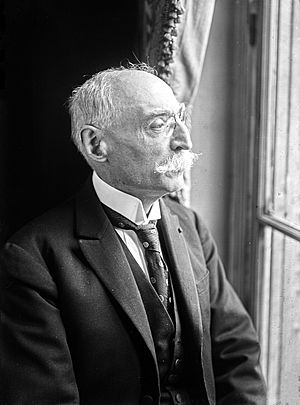Émile Mâle facts for kids
Émile Mâle (born June 2, 1862 – died October 6, 1954) was an important French art historian. He was one of the first people to deeply study medieval French art, especially religious art. He also looked at how art from Eastern Europe, like iconography (the study of symbols and images), influenced French art. Mâle was a member of the respected Académie française and led the Académie de France à Rome.
His Life and Work
Émile Mâle was born in Commentry, a town in the Auvergne region of France. He was a very bright student and studied at a top school called the École normale supérieure. He earned his degree in 1886.
After finishing his studies, Mâle taught at schools in Saint-Étienne and then at the University of Toulouse. He earned his doctorate degree in 1899. This is a very high academic qualification.
From 1906, he taught about the history of Christian art at the famous Sorbonne in Paris. By 1912, he became the head of the art history department there. Later, from 1923 to 1937, he was the director of the French Academy in Rome, which is a place where French artists and scholars can study in Italy.
One of Mâle's biggest contributions was helping people understand the meaning behind old religious art. He explained the iconography and how artists used allegory (stories with hidden meanings) in their religious paintings and sculptures.
His most famous work was his doctoral thesis, a book called L'Art religieux du XIIIe siècle en France (which means Religious Art of the 13th Century in France). It was first published in 1899. This book was later translated into English as The Gothic Image: Religious Art in France of the Thirteenth Century. It's still a very important book for studying medieval art today.
Émile Mâle passed away in Fontaine-Chaalis, France, in 1954.
Awards and Recognition
Émile Mâle received many important awards and was recognized by several famous groups for his work. These included:
- He became a member of the Académie des Inscriptions et Belles-Lettres in 1918.
- He was also a member of the Académie royale de Belgique (Royal Academy of Belgium).
- He joined the British Academy in the United Kingdom.
- He was a member of the prestigious Académie française in France.
- He received the high honor of Grand Officier of the Légion d'honneur, which is one of France's highest awards.
Key Books by Émile Mâle
Émile Mâle wrote many books that helped us understand art history better. Here are some of his most well-known works:
- L'Art religieux du XIIIe siècle en France (1899) – This was his famous book about 13th-century religious art in France. It's also known as The Gothic Image in English.
- L'Art religieux de la fin du Moyen Âge en France (1908) – This book focused on religious art from the late Middle Ages in France.
- L'Art religieux du XIIe siècle en France (1922) – This work explored religious art from the 12th century in France.
- Art et artistes du Moyen Âge (1927) – This book was about art and artists during the Middle Ages.
- L'Art religieux après le Concile de Trente (1932) – This book looked at religious art from the late 16th, 17th, and 18th centuries in different European countries.
- Notre-Dame de Chartres (1948) – A book specifically about the famous Chartres Cathedral.
See also
 In Spanish: Émile Mâle para niños
In Spanish: Émile Mâle para niños


